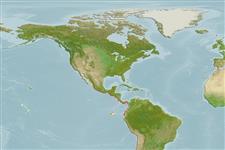Environment: milieu / climate zone / depth range / distribution range
Οικολογία
Θαλασσινό(ά) βενθικό(ς). Tropical
Eastern Central Pacific: Costa Rica to Ecuador.
Μέγεθος / Βάρος / Age
Maturity: Lm ? range ? - ? cm
Max length : 5.0 cm TL αρσενικό/απροσδιόριστο; (Ref. 11482)
Short description
Μορφολογία | Μορφομετρία
Body very small; possessing a thoracic adhesive disk formed by modification of the pectoral and pelvic fins; dorsal fin with 6 to 7 rays; anal fin with 5 to 7 rays; pectoral fins with 20 to 22 rays; maxillary with only incisiform teeth; body brown with blue and red reticulate bars and spots on the back and sides and scattered white spots that may form bars along the body (Ref. 55763).
Inhabits shallow rocky areas. Feeds on zooplankton, algae, and small benthic invertebrates.
Life cycle and mating behavior
Γεννητική Ωρίμανση | Αναπαραγωγή | Γεννοβολία | Αβγά | Γονιμότητα | Προνύμφες
Allen, G.R. and D.R. Robertson, 1994. Fishes of the tropical eastern Pacific. University of Hawaii Press, Honolulu. 332 p. (Ref. 11482)
IUCN Red List Status (Ref. 130435)
Threat to humans
Harmless
Human uses
Περισσότερες πληροφορίες
Κοινά ονόματαΣυνώνυμαΜεταβολισμόςΘηρευτέςΟικοτοξικολογίαΑναπαραγωγήΓεννητική ΩρίμανσηΓεννοβολίαΣυναθροίσεις γεννοβολίαςΓονιμότηταΑβγάEgg development
Age/SizeΑύξησηLength-weightLength-lengthLength-frequenciesΜορφομετρίαΜορφολογίαΠρονύμφεςΔυναμική προνυμφώνΣτρατολόγησηΑφθονίαBRUVS
ΑναφορέςΥδατοκαλλιέργειεςΠροφίλ υδατοκαλλιέργειαςΣτελέχοιΓενετικήElectrophoresesΚληρονομικότηταΑσθένειεςΜεταποίησηNutrientsMass conversion
ΣυνεργάτεςΦωτογραφίεςStamps, Coins Misc.ΉχοιΣιγκουατέραΤαχύτηταΚολυμβητικός ΤύποςΕπιφάνεια βραγχίωνOtolithsΕγκέφαλοιΌραση
Εργαλεία
Special reports
Download XML
Διαδικτυακές πηγές
Estimates based on models
Preferred temperature (Ref.
123201): 23.2 - 29.1, mean 27.3 °C (based on 225 cells).
Phylogenetic diversity index (Ref.
82804): PD
50 = 0.5312 [Uniqueness, from 0.5 = low to 2.0 = high].
Bayesian length-weight: a=0.00617 (0.00250 - 0.01521), b=3.15 (2.94 - 3.36), in cm total length, based on LWR estimates for this (Sub)family-body shape (Ref.
93245).
Τροφικό Επίπεδο (Ref.
69278): 2.9 ±0.31 se; based on food items.
Ελαστικότητα (Ref.
120179): Υψηλό, ελάχιστος χρόνος για διπλασιασμό πληθυσμού < 15 μήνες (Preliminary K or Fecundity.).
Fishing Vulnerability (Ref.
59153): Low vulnerability (10 of 100).
